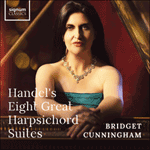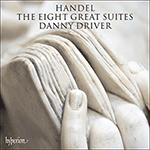Suite No 3 in D minor has a prelude which is a wildly whirling toccata with a dotted-rhythm subject in which the dots may or may not be reiterated throughout the entries. A dotted-rhythmed allemande reminds us that Charpentier had described the key of D minor as ‘grave et dévot’; and a certain wistfulness, if not gravity, is preserved in the Italianate corrente. But the next movement abandons the format of a conventional suite, being an air with variations. The air itself, like that of Bach’s ‘Goldberg’ Variations, is richly ornamented, and approaches Bachian sublimity. The five variations, however, eschew this old-world formal and spiritual grace, simply taking over the air’s harmonic base and adding lyrical semiquavers for the right hand. The second variation inverts this, placing the chord sequence in the right hand, the semiquavers in the left. The third variation has melodic but sturdily metrical parts for treble and bass which define the fundamental harmonies, leaving the semiquavers to form a middle part. The fourth variation jigs the tune in 12/8, and the fifth and final variation, in broken chords, is the plainest but also the most energetic. Unlike Bach, Handel does not return to his seraphically ornate aria but whisks this climactic variation into a final presto in 3/8, aggressive in muscularity, its thrust reinforced with trills.
from notes by Wilfrid Mellers © 1995
La
Suite no3 en ré mineur possède un Prélude qui est en fait une Toccata virevoltante, avec un sujet au rythme pointé dans lequel les points peuvent être réitérés ou non lors des entrées. Une Allemande «grave», au rythme pointé, nous rappelle que Charpentier avait décrit le ton de ré mineur comme «grave et dévot», et un certain désenchantement, sinon une gravité, est préservé dans la «Corrente» italianisée. Mais le mouvement suivant, une aria avec variations, abandonne la structure de la Suite conventionnelle. La mélodie elle-même, comme celle des Variations de Goldberg de Bach, est richement ornementée, et se rapproche de la sublimité de Bach. Les cinq variations, cependant, renoncent à cette ancienne grâce spirituelle et s’en tiennent simplement à la base harmonique de la mélodie, en ajoutant des doubles croches lyriques à la main droite. La seconde variation, à l’inverse, donne à la main droite une série d’accords, et des doubles croches à la gauche. La troisième variation possède des sections métriques solides et mélodiques pour soprano et basse, qui définissent les harmonies fondamentales et donnent l’occasion aux doubles croches de former la partie médiane. La quatrième variation secoue la mélodie en 12/8, et la cinquième et dernière variation, en accords brisés, est la plus simple mais aussi la plus énergique. Contrairement à Bach, Hændel ne retourne pas à son aria ornementée de façon séraphique, mais entraîne à toute vitesse cette variation culminante vers un Finale presto en 3/8, à la vigueur agressive, dont la puissance est renforcée par des trilles.
extrait des notes rédigées par Wilfrid Mellers © 1995
Français: Isabelle Dubois
Die
Suite Nr. 3 in d-moll besitzt ein Präludium in Form einer wild herumwirbelnden Toccata mit einem Thema in punktiertem Rhythmus, dessen Verlängerungspunkte bei jedem der Einsätze entweder wiederholt oder weggelassen werden können. Eine mit der Anweisung „grave“ versehene Allemande in punktiertem Rhythmus ruft uns ins Gedächtnis, daß Charpentier die Tonart d-moll als „grave et dévot“ beschrieben hatte; und eine gewisse Wehmut, wenn nicht sogar Schwermut wird in der Courante im italienischen Stil beibehalten. Im nächsten Satz, einer Air mit Variationen, verläßt Händel die Form der konventionellen Suite. Wie die Air in Bachs Goldberg-Variationen ist auch diese reich ausgeschmückt und kommt in ihrem erhabenen Klang der Bachschen Weise nahe. Die fünf Variationen enthalten sich jedoch dieser altehrwürdigen formellen und geistigen Anmut; sie eignen sich einfach die harmonische Grundlage der Air an und fügen lyrische, von der rechten Hand gespielte Sechzehntelnoten hinzu. Die zweite Variation kehrt dies um, indem sie nämlich die Akkordsequenz in die rechte Hand verlegt und die Sechzehntelnoten in die linke. Die dritte Variation besitzt melodische, aber unerschütterlich metrische Sopran- und Baßstimmen, welche die grundlegenden Harmonien determinieren und den Sechzehntelnoten erlauben, eine mittlere Stimme zu bilden. Die vierte Variation läßt eine in 12/8 daherhüpfende Melodie erklingen, und die fünfte und letzte Variation, die aus gebrochenen Akkorden besteht, ist die schlichteste, aber gleichzeitig auch die energischste. Im Gegensatz zu Bach kehrt Händel nicht zu seiner prunkvoll verklärten Arie zurück. Statt dessen treibt er seine Variation in einem abschließenden, kraftstrotzend aggressiven Presto in 3/8 zu einem Höhepunkt, in dem ihre Stoßkraft noch mit Trillern verstärkt wird.
aus dem Begleittext von Wilfrid Mellers © 1995
Deutsch: Angelika Malbert


 Handel: Eight Great Harpsichord Suites
Handel: Eight Great Harpsichord Suites Handel: The Eight Great Suites
Handel: The Eight Great Suites
